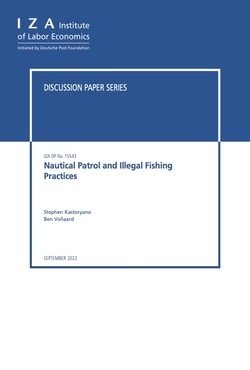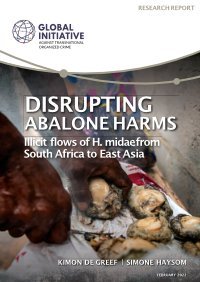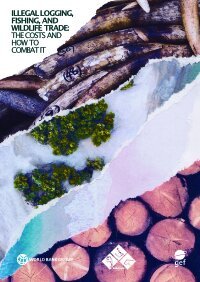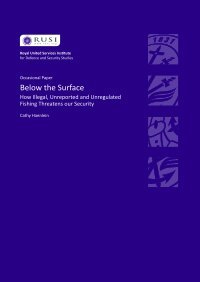By Lauren Young, Cathy Haenlein and Grace Evans
Comprising everything from small-scale, near-shore activity to industrial-scale, long-distance operations, the current IUU fishing threat has the potential to evolve significantly in a warming world. A global horizon scan explores the impacts of climate change on IUU fishing over the next 10 years and beyond.
Illegal, unreported and unregulated (IUU) fishing is a multifaceted global threat, occurring worldwide in inland waters, exclusive economic zones (EEZs) and on the high seas. Comprising everything from small-scale, near-shore activity to industrial-scale, long-distance operations, the current IUU fishing threat has the potential to evolve significantly in a warming world.
These evolutions stand to occur as fish populations themselves respond to a warming climate. Alongside critical stressors such as overfishing, oceanic warming is set to continue to contribute to an ongoing overall decline in fish populations globally. In parallel, there is evidence that key species are shifting poleward and to deeper waters, with declines in marine catch potential expected in the tropics. Combined with the effects of melting sea ice, changing weather patterns and the growth of marine heatwaves, among other factors, the impact on aquatic ecosystems is potentially highly destabilising.
These disruptive environmental changes have a range of potential implications for IUU fishing activity. The need to anticipate future trends across the threat landscape is thus pressing.
This paper presents the results of a global horizon scan conducted to explore the impacts of climate change on IUU fishing over the next 10 years and beyond.
The scan gathered globally available information by eliciting submissions from contributors worldwide, with a group of expert assessors collating and prioritising trends based on their ‘novelty’, ‘plausibility’ and ‘potential impact’. The scan produced a ranked list of 20 priority trends, categorised into four thematic areas. While the scan considered both emerging threats and opportunities, most of the 20 priority trends speak to emerging challenges, with potential options to address them where feasible and appropriate.
The first group of trends emerging from the scan covers evolving IUU fishing issues linked to shifting fish stocks and distributions. A number of these have the potential to challenge existing management and enforcement frameworks. Potential trends identified relate to an emerging ‘race to fish’ in the Arctic; ice loss and rising demand in the Antarctic; climate change impacts on the Humboldt Current System; novel interactions between mobile industrial fleets and smaller vessels; and domestic fishery closures potentially altering the length of supply chains.
The second group of trends relates to contested maritime boundaries and ungoverned spaces. Potential emerging trends include risks arising where fish cross between EEZs, and where sea-level rise feeds into maritime boundary disputes; evolving intersections between IUU fishing and geopolitical tensions in the South China Sea; the rising importance of IUU fishing in maritime security discourse; and the push to expand marine protected area (MPA) cover despite unresolved issues around the policing of MPA borders.
The third group of trends relates to evolving socioeconomic and criminological dynamics across small-scale IUU fishing and larger-scale operations. Potential issues include the incentivisation of IUU activity as livelihoods are undermined; risk-taking and vulnerability in the face of extreme weather; reliance on illegal labour practices in the face of reduced profitability; and evolving criminal tactics and patterns of crime convergence with growing seafood scarcity.
The fourth group of trends relates to challenges and opportunities for monitoring and enforcement. Potential emerging issues relate to vessel monitoring capabilities to detect climate-driven changes in IUU activity; gaps around the evaluation of interventions; persistent weaknesses in the transnational response; port infrastructural upgrades; and mounting public pressure for transparency.
To support efforts to address these trends, this paper offers a set of broad considerations for the range of stakeholders involved in the global response to IUU fishing. With future policy unable to address climate impacts in isolation, these are designed to be considered in the wider context of other evolving aspects of fisheries management.
Advance planning is essential. Many identified potential impacts of climate change are rooted in already visible trends, with advance action needed given the time required to update multilateral agreements, for example. Dedicated monitoring is needed to track changes in fish stocks relative to specific governance arrangements, as are forward-looking fisheries crime assessments.
Vessel-monitoring capabilities must be bolstered to detect climate-driven changes in activity. IUU fishing vessels could exhibit greater spatial mobility as they pursue shifting fish stocks, yet numerous gaps persist in vessel identification and monitoring capabilities. Gaps in state-level capacity to analyse unprocessed data continue to act as a barrier, with sustained work to build analytical capacity required.
Enforcement must be strengthened and adapted to a climate-changed future. With perpetrators of large-scale IUU fishing potentially becoming increasingly geographically mobile, gaps in international cooperation must be addressed. Systematic evaluation of existing enforcement, mitigation and deterrence methods is also needed to inform future interventions. Beyond this, challenges around the policing of expanding MPAs must be addressed.
Enhanced transparency and traceability must be pursued. As fish distributions shift and potentially alter the length of supply chains, responses continue to be hindered by a lack of transparency. Fishing-specific transparency legislation should be passed, ultimate beneficial ownership registries expanded, and schemes such as the Fisheries Transparency Initiative supported.
Geopolitical stakes woven into fishing activity must be accounted for. As stocks of key species decline and their distributions shift, new juxtapositions of marine biomass concentration and fishing effort across jurisdictional boundaries risk altering the geopolitical stakes involved. A clear focus on fisheries is needed as part of wider efforts to build mutual trust and cooperation in affected areas.
Resilience among artisanal fishing communities must be strengthened. In a range of locations, climate change could affect the vulnerabilities facing fishing-dependent communities as key species shift out of reach to deeper, cooler waters. Evidence-based measures must be enacted to enhance resilience to climate change, including long-term ‘pro-poor’ strategies to strengthen adaptive capacities.
High-volume IUU fishing must be treated with the severity it deserves. With IUU fishing often treated as a minor issue, the disconnect between crime type and response could grow, as shifting fishing grounds potentially increase IUU actors’ reliance on sophisticated organised criminal operations. National legislation must be updated such that large-scale IUU fishing qualifies as a serious crime per the UN Convention Against Transnational Organized Crime, with enforcement responses tailored to address shifting crime convergence.
London: RUSI, Royal United Services Institute for Defence and Security Studies, RUSI Occasional Paper, March 2023. 67p.





















